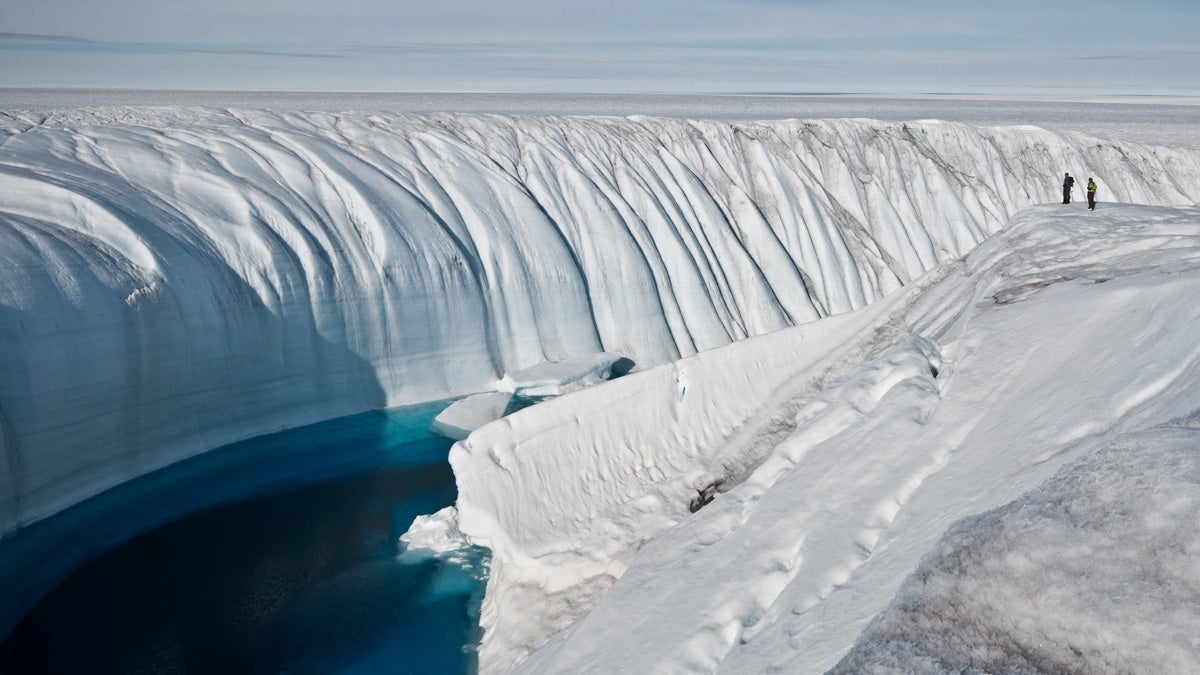Skepticism of rising sea levels could impair New Jersey’s preparedness

Polar ice sheets are now melting three times faster than in the 1990s. The acceleration of the melting, especially in Greenland, has ice scientists worried. (AP Photo/Ian Joughin)
“Think of a basketball player dunking a ball,” says Ben Strauss of Climate Central, a news organization focusing on the science of climate change. “It’s hard to dunk, a dunk happens every once in a while, but it’s a pretty rare event. Now what happens if you raise the basketball floor by a few inches?” The result, he says, is that a lot more people would dunk the ball. And if you raise the floor even more, there would only be dunks.
Strauss uses this analogy to explain how just a few inches of change can lead to large consequences, not just in the world of professional sports, but also when it comes to sea levels and their potential impact on flooding. Scientists predict waters along New Jersey’s coast could rise as much as three-and-a-half feet by the end of the century, compounded by the fact that the Jersey Shore is slowly sinking. What’s more, warns Boston University Earth and Environment Professor Tony Janetos, this isn’t just a problem for our children and grandchildren. It’s happening now.
Strauss and Janetos were among nearly two dozen panelists who took part in a day-long conference held at Monmouth University yesterday to coincide with the one-year anniversary of Hurricane Sandy. The event was presented by New Jersey Future, in collaboration with the Union of Concerned Scientists, the New Jersey Recovery Fund, and the university. The overall focus was on how to rebuild the coast to prepare for the impacts of climate change.
Various speakers said Sandy should serve as a wakeup call, and they expressed concern that not enough is being done to prepare the state for future storms. New Jersey needs to take more of a hands-on approach, they said, incorporating longer range thinking into its planning efforts. The Christie administration has so far refused to consider climate change to the extent that New York, Connecticut, Delaware, and many other states in the region have done.
The problem, noted former New Jersey Governor and one-time EPA Commissioner Christine Todd Whitman, is that it can be a challenge getting people to change their behavior for a problem they might not see or even believe is real. But while some members of the public might remain skeptical about the threat of climate change, it’s a real concern for PSE&G President Ralph LaRossa. LaRossa described how flooding from Sandy knocked offline the utility’s Sewaren Substation in Woodbridge Township, after salt water oxidized all the plant’s DC circuitry. The utility couldn’t replace all the equipment, because there simply weren’t enough spare parts easily accessible on such short notice, so he says it took “a lot of guys with toothbrushes and rags” to clean each of the contacts and miraculously get the plant back online within three days.
“What keeps me up now,” he said, “is that’s just like those old transistor radios you had when you were a kid. You drop them in the water, shake them out, and they work, but next summer, go back and try to turn them on.”
La Rossa said PSE&G’s experience with Sandy has firmly made the case for reevaluating long-term strategies like where to locate substations and how high to elevate electrical infrastructure going forward. “We’ve got to think about this now,” he said. “We’ve got a golden opportunity. We need to rebuild it the right way.”
In terms of lessons learned, John Miller from the NJ Association for Floodplain Management said that many local governments were woefully unprepared for Sandy. They didn’t have proper safety equipment, training, or staffing to deal with the storm, and some towns were uninformed of the first steps they needed to take to start the recovery process. With so many tiny towns along the coast, regional cooperation and more state leadership is key, he said, to better resiliency and recovery from future storms.
He noted some sobering statistics. New Jersey has had 11 presidential disaster declarations related to flooding over the past eight years. The state also ranks third in the nation in federal flood insurance payouts since 1978, coming close to surpassing Texas and assuming second place. “New Jersey still is not getting that we have a flood-prone state,” he said joking that the first step in any 12-step program is to admit that you have a problem.
Some speakers speculated that elected officials would only address these issues once the public demanded it, a reference to the axiom that if the people lead, the leaders will follow. But in his closing remarks, former New Jersey Governor James Florio disagreed. “I think that lets people off the hook at the leadership level,” he said. “All the groups that are out there talking about this, all these ideas are great. The problem is, who is gonna have the final authority to make determinations as to what we do? Do we act fast, or do we act smart?”
____________________________________________________
Scott Gurian is the Sandy Recovery Writer for NJ Spotlight, an independent online news service on issues critical to New Jersey, which makes its in-depth reporting available to NewsWorks.
WHYY is your source for fact-based, in-depth journalism and information. As a nonprofit organization, we rely on financial support from readers like you. Please give today.




